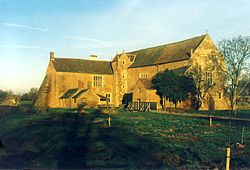Acton Court: Difference between revisions
Created page with "{{Infobox house |name=Acton Court |county=Gloucestershire |picture=Acton Court (3001219432).jpg |picture caption=Acton Court, view from north-west |os grid ref=ST67708419 |lat..." |
No edit summary |
||
| Line 23: | Line 23: | ||
[[File:Acton Court, Iron Acton, Gloucestershire.jpg|right|thumb|200px|Acton Court, south front]] | [[File:Acton Court, Iron Acton, Gloucestershire.jpg|right|thumb|200px|Acton Court, south front]] | ||
[[File:Acton Court, Gloucestershire (3013041037).jpg|thumb|200px|Acton Court, detail of west gable]] | [[File:Acton Court, Gloucestershire (3013041037).jpg|thumb|200px|Acton Court, detail of west gable]] | ||
When the direct line of succession ended in 1680, the house was sold. It was reduced in size and converted for use as a tenanted farmhouse. Due to neglect, the house gradually fell into a dilapidated state. By the end of the 20th century, practically only the East Wing survived. However, the neglect resulted in a rare example of Tudor royal state apartments being preserved virtually intact. The house was purchased at auction in 1984 by Eva Dorothy Brown on behalf of the Bristol Visual and Environmental Group (BVEG).<ref> | When the direct line of succession ended in 1680, the house was sold. It was reduced in size and converted for use as a tenanted farmhouse. Due to neglect, the house gradually fell into a dilapidated state. By the end of the 20th century, practically only the East Wing survived. However, the neglect resulted in a rare example of Tudor royal state apartments being preserved virtually intact. The house was purchased at auction in 1984 by Eva Dorothy Brown on behalf of the Bristol Visual and Environmental Group (BVEG).<ref>[http://www.bveg.org.uk/further.html Bristol Visual and Environmental Group]</ref> An extensive restoration was completed only recently. | ||
Prior to the restoration, English Heritage commissioned a comprehensive study, published as K. Rodwell and R. Bell, ''Acton Court: The evolution of an early Tudor courtier's house'' (2004). | Prior to the restoration, English Heritage commissioned a comprehensive study, published as K. Rodwell and R. Bell, ''Acton Court: The evolution of an early Tudor courtier's house'' (2004). | ||
Latest revision as of 22:50, 30 November 2019
| Acton Court | |
| Gloucestershire | |
|---|---|
 Acton Court, view from north-west | |
| Location | |
| Grid reference: | ST67708419 |
| Location: | 51°33’20"N, 2°28’2"W |
| History | |
| Country house | |
| Information | |
| Website: | actoncourt.com |
Acton Court is the historic manor house of the manor of Iron Acton in Gloucestershire. It is a Grade I listed building[1] of Tudor architecture and was recently restored.
The house stands at some considerable distance from the village of Iron Acton and the parish church of St Michael. The Poyntz family owned the property from 1364 until 1680. Nicholas Poyntz (died 1557) added the East Wing onto the existing moated manor house shortly before 1535. Construction took about 9 months to complete. Subsequently, the wing was lavishly and fashionably decorated to impress Henry VIII. The king and his second wife, Anne Boleyn, stayed in the house in 1535, during a tour of the West Country. Building work continued at Acton Court until Nicholas died in 1557.


When the direct line of succession ended in 1680, the house was sold. It was reduced in size and converted for use as a tenanted farmhouse. Due to neglect, the house gradually fell into a dilapidated state. By the end of the 20th century, practically only the East Wing survived. However, the neglect resulted in a rare example of Tudor royal state apartments being preserved virtually intact. The house was purchased at auction in 1984 by Eva Dorothy Brown on behalf of the Bristol Visual and Environmental Group (BVEG).[2] An extensive restoration was completed only recently.
Prior to the restoration, English Heritage commissioned a comprehensive study, published as K. Rodwell and R. Bell, Acton Court: The evolution of an early Tudor courtier's house (2004). The monograph is now publicly available through the Archaeology Data Service
Outside links
- Acton Court
- A House Fit for a King: a history of Acton Court by Jean Manco from Bristol Past.
References
- ↑ National Heritage List 1320155: Acton Court, and Gateway and Flank Walls
- ↑ Bristol Visual and Environmental Group
- Faulkner, Neil: Current Archaeology, May 2008; Volume 19, No.2 issue 218, pages 14–21: 'A goodly howse': the rebuilding of Acton Court
- Rodwell, Kirsty; Bell, Robert: [http://archaeologydataservice.ac.uk/archives/view/eh_monographs_2014/contents.cfm?mono=1089013 Acton Court. The evolution of an early Tudor courtier's house (English Heritage, 2001) ISBN 1-873-59263-9